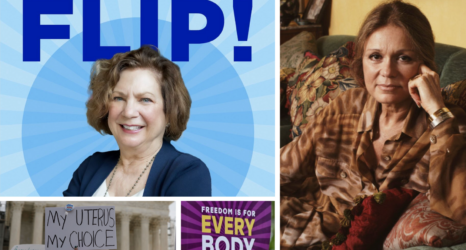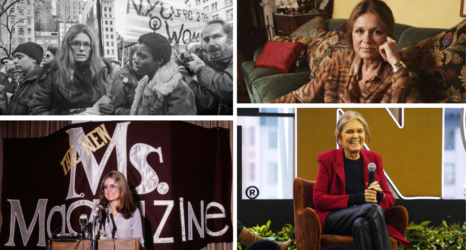Bold moves and high-risk strategies have been a feminist tradition since the days of Alice Paul and Susan B. Anthony. But on March 20, 1970, when Betty Friedan gave her farewell address as outgoing president of NOW and called for a nationwide women’s strike on August 26 (the 50th anniversary of winning the vote), the other officers in the room were surprised, to put it mildly.
According to a New York Times article on March 21, 1970, Friedan (who is called “militant leader” in the headline) wanted “an instant revolution against sexual oppression” and proposed that:
The women who are doing menial chores in the offices as secretaries put the covers on their typewriters and close their notebooks and the telephone operators unplug their switchboards, the waitresses stop waiting, cleaning women stop cleaning and everyone who is doing a job for which a man would be paid more stop … And when it begins to get dark, instead of cooking dinner or making love, we will assemble and we will carry candles alight in every city to converge the visible power of women at city hall … Women will occupy for the night the political decision-making arena and sacrifice a night of love to make the political meaning clear.
That was a tall order for a three-and-a-half-year-old organization like the National Organization for Women, with 3,033 members, 35 chapters and an annual budget of $38,000, to carry out. Formal organizations were surely just the tip of feminism’s iceberg, however, and Betty was certain that somewhere out there were a lot of women who would march and protest if given a time and place to do so. But they had better show up, because every media outlet would see August 26, 1970 as the test of feminism’s credibility and power.
NOW officially endorsed the idea, and three days later announced that the strike on August 26, 1970, would commemorate both the date that the 19th Amendment was ratified and “signal the start of a major political effort for the liberation of the women of the United States of America.”
Though the three main purposes of the action were (a) repeal of antiabortion laws (b) establishment of child-care centers, and (c) equal opportunity in jobs and education, the media had a field day ridiculing a “women’s strike,” with as many references to Lysistrata as your average Greek literature class. But the later stories often noted when and where a local rally or protest would be, so the word got out that this was more than a “strike” and there were many ways to show support for equality.
August 10 brought the first hint of actions to come. According to an Associated Press article the following day, about a hundred women went out to “liberate” the Statue of Liberty, unfurling a banner on her pedestal reading “Women of the World Unite” as a way of publicizing the upcoming strike and march. But while there were hints of a groundswell of support as the Big Day drew near, there was really no way of knowing whether the turnout would match the expectations.
“Equality Week” was literally kicked off in Boston by a karate demonstration on August 23, while an ad-hoc coalition of 52 groups finalized their plans for New York’s events. The march down Fifth Avenue was still to be restricted to only one lane, a plan city authorities felt was more than adequate for the number of marchers they expected.
When August 26 arrived, the first planned events–from leafleting to guerrilla theatre–went off as scheduled, and as the day went on one could see women’s rights banners hanging from windows. Finally, the moment of truth: How many would be at the assembly area to march?
It was a “sea of people”–far larger than anyone had dared hope. It easily rivaled, and according to some estimates exceeded, the largest suffrage marches the city had seen more than half a century before. Not only were numerous feminist organizations represented, but even passersby who knew nothing of the march spontaneously joined in their first feminist action. The assembly point filled to capacity, and as more kept arriving and trying to wedge their way in the marchers exploded into the street, tossing barriers aside as they took up every square inch of pavement from sidewalk to sidewalk. There were chants, buttons, signs (“Don’t Iron While The Strike Is Hot”) and props such as a giant typewriter chained to several marchers.
The rally at the end of the march was successful as well, with Bella Abzug, Gloria Steinem, Betty Friedan and many others telling politicians, press and other skeptics who didn’t believe that American women had any meaningful discontent with the status quo, “We told you so.”
The enthusiasm of that day spanned the nation, with marches and other events in 90 cities and 42 states. “Freedom Trash Cans” were set up from Syracuse, N.Y. to the Pentagon, where “objects of oppression” such as aprons and hair curlers were deposited (no husbands, however, despite many wry predictions.) In Miami, feminists smashed coffee cups to show that making coffee instead of policy was no longer enough for women in politics. In Los Angeles there was a march, rally and a tribute to living suffragists, plus lines of women dressed in white bearing banners like those of the “Silent Sentinels” who picketed President Wilson to prod him into supporting suffrage. There were “baby-ins” at offices by employed mothers to show the need for day care, and a plaque “consecrating” a site to a future statue of Susan B. Anthony was placed in a New York park to highlight the fact that the only statue of a female in the nation’s largest city other than the Statue of Liberty was one of Alice in Wonderland.
There are few times when it can clearly be said that an idea or movement’s time has come. For the Second Wave of feminism to go from just 28 people meeting in a hotel room on June 29, 1966 to the nationwide outpouring of August 26, 1970 proves that this was one of those occasions. So Equality Day should really be a double celebration, honoring the events and pioneers of both 1920 and 1970, as the younger feminists of 2010 join veterans of the movement in the next stage of the battle for equality.
Photo of marchers in New York City during the massive August 26, 1970 strike.





